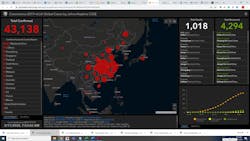China nCoV cases top 43,000, with more tied to French cluster
China's novel coronavirus (2019-nCoV) total grew by just over 3,000 new cases, as an advance team from the World Health Organization (WHO) arrived in the country to lay the groundwork for an international joint mission with Chinese colleagues. According to Johns Hopkins, there are now over 43,000 worldwide cases and over 1000 deaths. So far, 4294 people have recovered from the virus, and the U.S. now has its 13th case in San Diego.
In other developments, more illnesses were reported with links to a family cluster centered at a French ski resort, two of them involving healthcare workers. Also, infections on a cruise ship docked in Japan grew by 60, and new estimates from Imperial College London put the overall fatality ratio at 1%, but higher in China's main hot spot. Additionally, an animal (mice) trial of a candidate mRNA vaccine against 2019-nCov has launched according to Xinhua, China's state news agency. It said testing is at a very early stage, and the next step will be toxicity tests in larger animals.
In addition, two genomes from environmental samples taken from the outbreak market in Wuhan have been submitted to the GISAID database, and they cluster with the early human samples, adding to evidence that the market is the focus of the outbreak.
At a media telebriefing, WHO Director-General Tedros Adhanom Ghebreyesus, PhD, said three members of an advance team has arrived in China to lay the groundwork for an international expert team—comprising 10 to 15 people—to meet with Chinese officials. The WHO's team is led by Bruce Aylward, MD, MPH, a Canadian physician who led the launch of the WHO's health emergencies program and the WHO's West Africa Ebola outbreak response. Mike Ryan, MD, who directs the WHO's health emergencies program, said the goals of the joint mission are to learn more about the nature of the 2019-nCoV threat from Chinese health officials and to exchange ideas. He added that many of the experts already know their colleagues in China, and that the joint mission offers a chance to reconnect.
In other WHO developments, a two-day international global research and innovation forum to lay out an international action plan to battle 2019-nCoV begins February 11 in Geneva. It will bring together leading scientists, public health agencies, health ministries and research funders. The end result is expected to be a research agenda, as well as a list of priorities, to guide which projects groups tackle first, with an eye toward fast-tracking the development and testing of diagnostic tests, vaccines and therapies.
The U.K. reported its fourth case, and then four more, all linked to a British man who contracted the virus at a meeting in Singapore, then traveled to a ski resort in France, where he passed it to five people, all members of a British family—four adults and a child. Public Health England (PHE) said two of the U.K.'s four new cases involve healthcare workers, who have been asked to self-isolate, The Guardian reported, citing Yvonne Doyle, MD, MPH, the PHE's medical director. The BBC reported that the two are general physicians and that a GP practice in Brighton has been closed after a staff member tested positive.
At a media briefing, Tedros said the WHO is worried about instances of onward transmission, such as those occurring in France and the United Kingdom, which he called a small spark that becomes part of a bigger fire. "Right now, it's a spark, and the goal is containment," he said.
Ryan said 12 cases outside of China have been linked to a business meeting at a hotel in Singapore, which he said isn't classified as a super-spreading event.
Japan's health ministry reported that 65 more passengers on the quarantined cruise ship have tested positive for 2019-nCoV, raising the total to 135, according to a health ministry statement. The Diamond Princess has been in Yokohama port since Feb. 3. The WHO said in its situation report that the main quarantine period will end on Feb. 19, but quarantine will be extended beyond that for close contacts of the newly confirmed cases. Boat passengers are asked to stay in their cabins and wear a mask when they need to leave their cabins.
In its fourth analysis on the outbreak, which focuses on outbreak severity, the MRC Center for Global Infectious Disease Analysis at Imperial College of London estimated that the overall case fatality ratio (CFR) is 1 percent. For cases in travelers outside of mainland China, which involve a mix of severe and milder cases, they estimated the CFR to be one percent to five percent. And for cases in Hubei, which tilt toward severe cases, the group estimated the CFR to be 18 percent. The group cautioned that the estimates don't reflect underlying differences in disease severity among countries, and they added that CFRs in different countries will vary based on how sensitive surveillance systems are at picking up different severity levels and the type of clinical care that severely ill patients receive.
"All CFR estimates should be viewed cautiously at the current time, as the sensitivity of surveillance of both deaths and cases in mainland China is unclear," they wrote, noting that data on time intervals from symptom onset to death or recovery influences CFR estimates.
In related news, Singapore reported two more cases, one of them locally acquired and one involving an evacuee from Wuhan, the health ministry said in an update. The country now has 45 cases, some of which involve three known clusters, including the private business meeting linked to a handful of exported cases.
The United Arab Emirates (UAE) reported its eighth case, the WHO's Eastern Mediterranean regional office said on Twitter. In another tweet, the UAE's health ministry said the patient is an Indian national and that the earlier reported patients are in stable condition, except for one who is in the intensive care unit.
